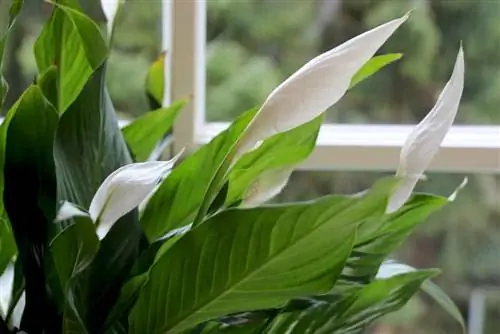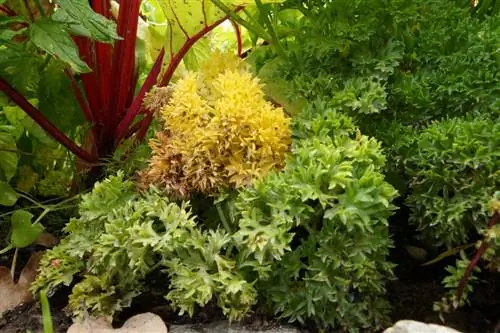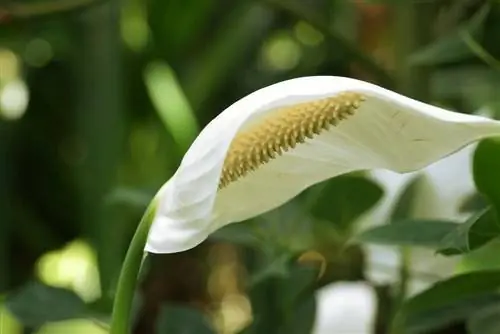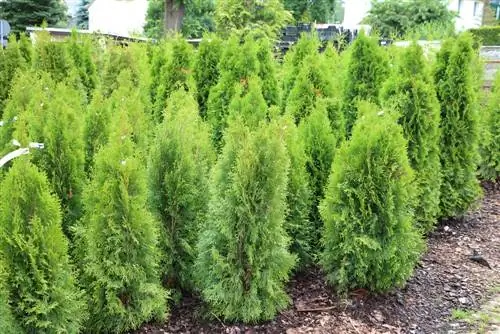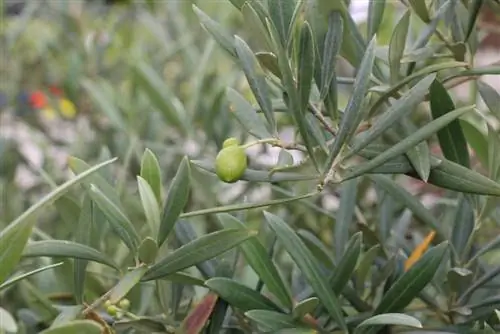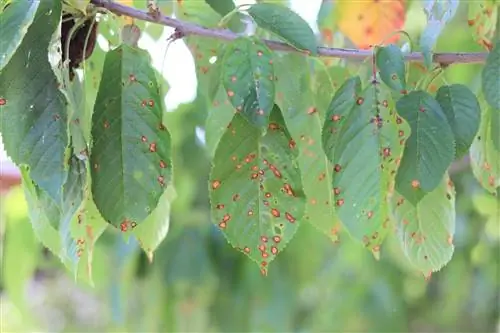- Author admin [email protected].
- Public 2023-12-17 03:39.
- Last modified 2025-01-24 12:45.
Glistening green leaves sprout from numerous long stems from a low, barely noticeable trunk. In summer, a few cream-colored flower heads follow, each surrounded by a white bract. There is no more elegance. If the color brown squeezes in unattractively, the leaflet is not entirely satisfied with its living conditions. Now it's time to find out what's bothering you and adjust it according to your wishes.
One color, many possible causes
Caring for a houseplant involves a bunch of different activities. Mistakes can be made with almost any of them. The single leaf usually responds to this by turning its leaves brown. However, if care ignores its needs for a long time, the otherwise very robust plant could eventually die completely. That's why it's important to find out about the needs of Spathiphyllum, as this ornamental plant is botanically called, and to compare them with the actual circumstances. In particular, you should check these aspects:
- Light conditions
- Room temperature
- Humidity
- Watering behavior
- Fertilize
- maybe. Pest infestation
- Pot size
Provide a location with optimal lighting conditions
The single-leaf plant comes from the tropics, where countless plants grow close together and therefore have to compete for light. Hardly any of them can claim full brightness and have necessarily adapted to the lack of light in their development, including this plant.
- must not be exposed to direct sunlight
- gets by with little daylight
- partially shaded place is optimal
- still thrives in the shade
- North window is ideal
- Avoid south windows at all costs
If the current location does not have the characteristics described above, you should definitely give your houseplant a change of location. Brown leaf tips in particular are a sure sign of too much direct sun.
Avoid temperatures below the tolerance limit
It goes without saying that a tropical plant like the Spathiphyllum loves warmth. This is also the reason why it is only cultivated as a houseplant in this country. It's not just about avoiding winter frosts outdoors, the single leaf also doesn't like low temperatures.
- ideal is 18 to 25 degrees Celsius
- It can be a little cooler in winter than in summer
- but under no circumstances fall below 16 degrees Celsius
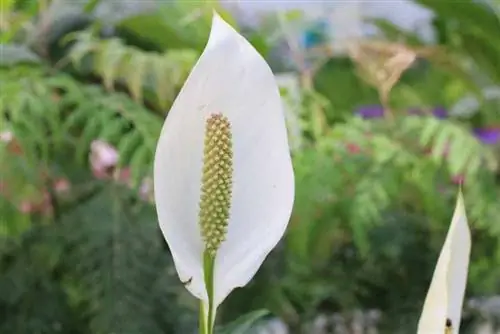
Inhabited rooms usually have a room temperature that is within the comfort range of this plant. The cold is therefore rarely the cause of brown leaves, but occasionally this circumstance occurs. For example, if the houseplant is in an unheated stairwell, the temperature could drop too low in a cold winter. Make sure that the leaflet does not have to experience temperatures below 16 degrees; it may have to be moved in the winter.
Provide almost tropical humidity
High humidity of around 70%, as is the norm in the tropics, will hardly be possible in our inhabited rooms. Fortunately, deviations are tolerated by the plant to a certain extent. Just like I said: to a certain extent! If the air is too dry, the leaves turn brown. Measure the humidity with a hygrometer, which can be bought cheaply in stores. The following conditions are acceptable for Spathiphyllum:
- at least It should be 50% humidity
- There are problems on warm summer days
- then the air is very dry
- spray the leaves regularly with water
- not the flowers
- the bathroom offers the ideal warm, humid environment
- in the planter pot add some water for evaporation
- Place the plant on larger pebbles
- this prevents the roots from standing in water
Tip:
Make sure you use soft water not only when watering, but also when spraying the leaves. Collected rainwater is ideal, tap water may need to be decalcified beforehand depending on the degree of hardness.
Align watering with needs
Watering houseplants is not as easy as it first seems. A bit of sensitivity is always required. Very often it means keeping moist throughout but not causing moisture. This moto also applies to Spathiphyllum. Only the top layer of soil is allowed to dry for a short time. Therefore the following applies to watering:
- do not water at fixed intervals
- examine the earth first
- Align water quantity with requirements
- water more often and more on warm days
- water more sparingly from October to January
- generally it is better to water more often with smaller amounts
- use room temperature, decalcified water
- pay attention to peat-containing, slightly acidic substrate
- spray leaves additionally on warm days
Tip:
The oak leaf is considered one of the best plants for hydroponics. This type of cultivation makes moisture regulation easier.
Consciously dose nutrients
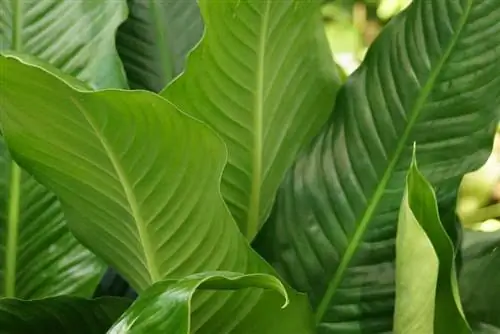
The single-leaf plant needs nutrients to thrive. In the first few weeks after planting, the fresh soil still offers plenty of it. The nutrient depot must then be replenished regularly.
- fertilize every two weeks during the flowering period
- with a liquid fertilizer
- Water the plant well beforehand
- be sure to follow the dosage recommendations
- fertilize only every three weeks in winter
If you measure the amount of fertilizer based on your feeling, you can quickly over-fertilize the plant. The single leaf with brown leaf tips shows his dissatisfaction with a well-intentioned supply.
Tip:
If the nutrient supply has been abundant over a long period of time, it is better to replace the soil.
Check for pest infestation
If the desire for consistently moist soil is not fulfilled, there is another threat to the beautiful green leaves: spider mites. These occur more frequently when the soil dries out significantly. Their presence also leads to brown leaves.
- Check plants regularly for infestation
- yellow spots on leaves are a possible clue
- Isolate plant
- shower with water
- treat with neem oil
Tip:
Check neighboring houseplants for spider mites, as they like to hop from plant to plant.
Check whether repotting is due
Repotting may be necessary for two reasons. On the one hand, the current pot may have become too small. The roots do not have enough space to grow and can no longer support the plant well. The result is brown leaves. It is also possible that some of the roots are damaged due to waterlogging. The plant dies of thirst because the damaged roots cannot absorb enough water.
- cut off broken roots with a sharp knife
- Repot the plant in fresh soil
After some time, the plant will recover and form new, he althy roots. This means that the future belongs exclusively to green leaves.
Always check care from A to Z

For example, if you have noticed that your specimen is too sunny, you have discovered a likely cause of brown leaves. Giving it a new location is the only correct consequence. Nevertheless:
- the search for the cause must not stop at this point
- there can be several causes at the same time
- z. B. Over-fertilization and air that is too dry
Then the new location will not be able to provide complete relief. If you try to investigate the cause again after a few days, it could be too late for the plant's vitality.
What to do with brown leaves?
Brown leaves don't have to spoil the beautiful sight. They can be separated from the plant with sharp scissors. If they are already very dried out, they can often be removed from the plant by hand.

